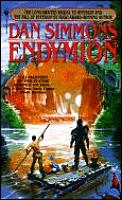
| Series: | Hyperion #3 |
| Publisher: | Bantam |
| Copyright: | 1995 |
| Printing: | December 1996 |
| ISBN: | 0-553-57294-6 |
| Format: | Mass market |
| Pages: | 563 |
It's 250 years after the events of The Fall of Hyperion. The book opens with a prisoner in a creative execution device, writing the story of how he became the bodyguard of the One Who Teaches, the messiah foreshadowed and foretold at the end of The Fall of Hyperion, who turns out to be a twelve-year-old girl (at least at the start of this story). His story begins as a native guide to off-world hunters on now-familiar Hyperion and then develops into a travelogue and chase through some of the worlds of the old Hegemony.
Endymion is the weakest book of the Hyperion series. While some hooks were left for a sequel, Endymion feels a bit bolted on at times and Simmons engages in some retconning (retroactively changing or reinterpreting the past story). It's also a less interesting story; it doesn't have the storytelling brilliance of Hyperion or the space opera sweep of The Fall of Hyperion, and sometimes feels boring or pointless. It is mostly a travelogue; how much you enjoy the book is likely to have a lot to do with how interesting you find the exploration of the worlds of the old Hegemony.
There is a larger plot, though. Endymion introduces the Pax, the new government that has taken over after the conclusion of The Fall of Hyperion and now dominates mankind far more than the Hegemony did. Half the book is told from the perspective of Raul Endymion and the other half from the perspective of a priest of the Pax who is chasing Raul and Aenea, and the Pax sections I thought were the strongest of the book. The Pax government is chilling but believable given their technology, and for most of the book Simmons does a good job slowly building a picture of their nature and motives. Unfortunately, he then spills many of the beans in exposition near the end of the book rather than giving the reader a chance to put two and two together, which partly spoils the effect.
Much of the trouble with Endymion is that it's a bridge book. It's trying to take the world of a mostly completed space opera story and prepare it as a backdrop in which to tell a very different story about religion, belief, and messiahs. Accordingly, it is neither fish nor foul, ends up feeling occasionally forced, and leaves one with the feeling that not a lot really happened. The Rise of Endymion is the real payoff to this story, and Endymion serves primarily to get the reader to the point where that story can be told.
I understand why people don't like this book. I still did like it, due largely to the enjoyable conversation with Marin Silenus at the beginning of it, the Pax portions of the book, and Aenea. Aenea becomes one of my favorite fictional characters in The Rise of Endymion, but her self-confidence and playfulness are already present here. But this isn't Hyperion or even The Fall of Hyperion; expect the process of setting up the story to feel awkward.
Followed by The Rise of Endymion.
Reviewed: 2004-12-26